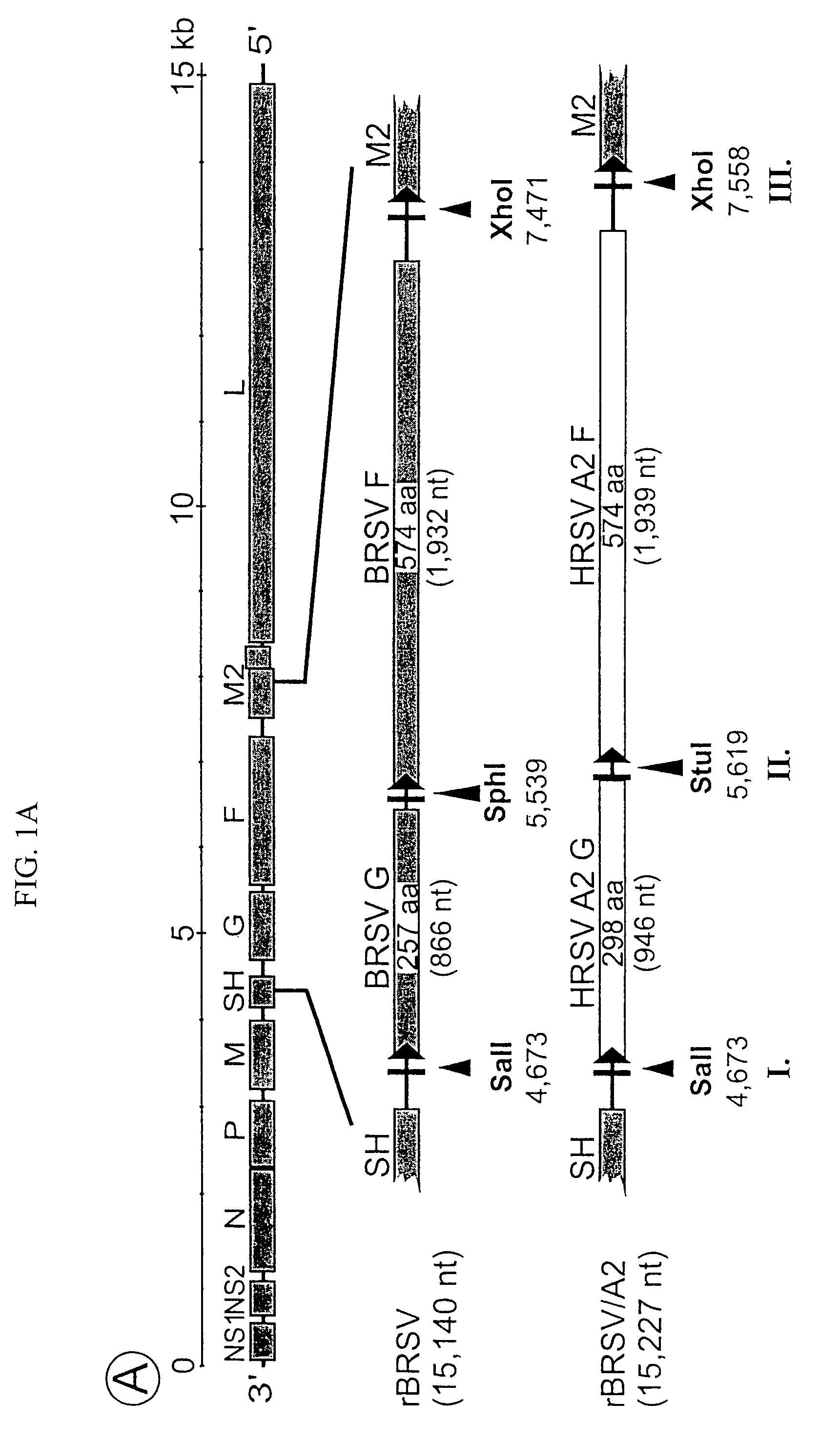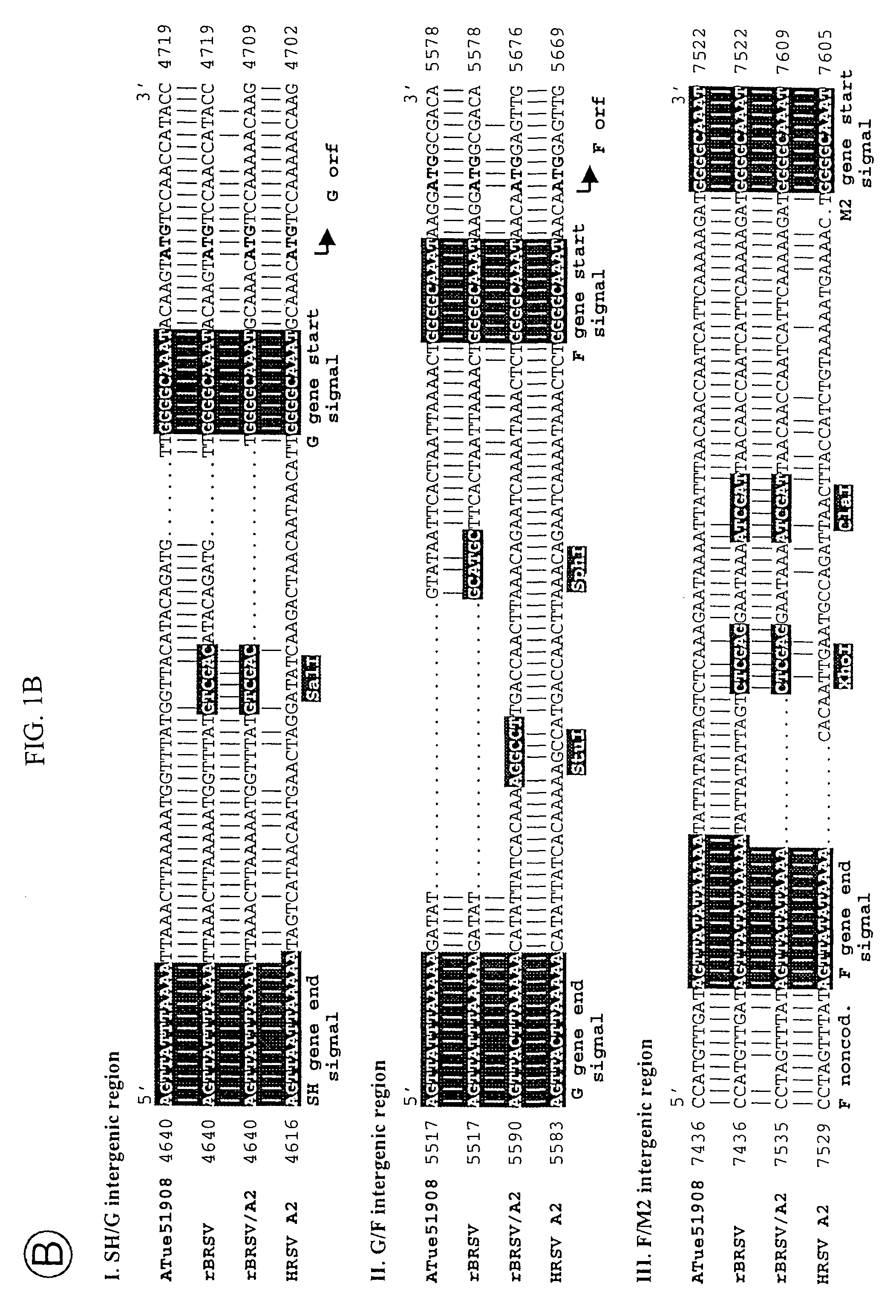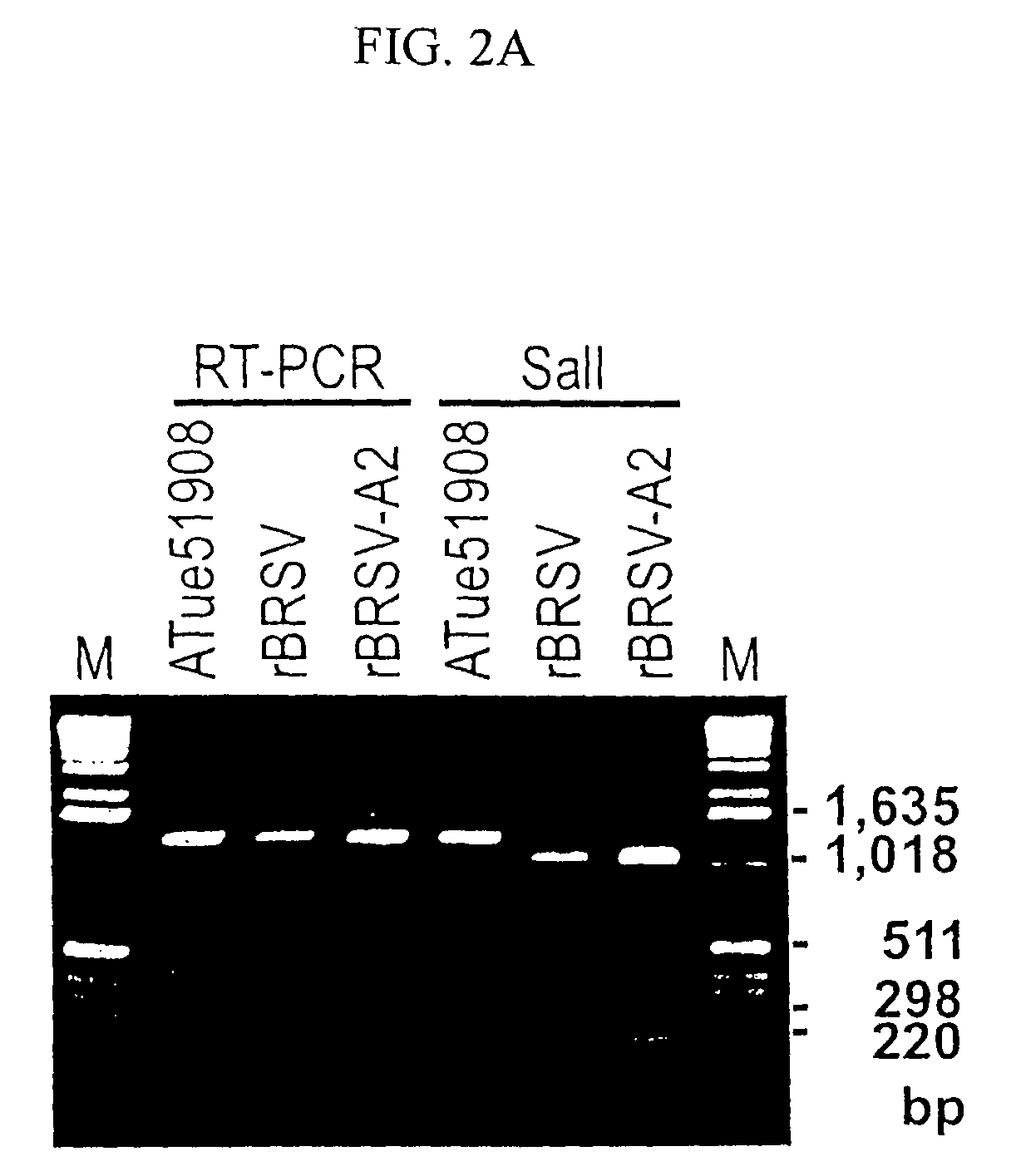Production of attenuated, human-bovine chimeric respiratory syncytial viruses for use in immunogenic compositions
a technology of chimeric respiratory syncytial virus and attenuated human body, which is applied in the direction of antibody medical ingredients, peptide sources, peptides, etc., can solve the problems of inability to transmit blood-borne viruses, inconvenient use, and inability to achieve widespread use, so as to achieve high permissive growth
- Summary
- Abstract
- Description
- Claims
- Application Information
AI Technical Summary
Benefits of technology
Problems solved by technology
Method used
Image
Examples
example i
Construction of cDNA Encoding a Chimeric BRSV / HRSV Antigenome and Recovery of Infectious rBRSV / A2 Chimeric Virus
[0223]Infectious rBRSV can be recovered from cloned cDNAs encoding a viral antigenomic RNA and the N, P, M2-1 and L support proteins (Buchholz et al., J. Virol. 73:251-259, 1999), using a strategy similar to that described for HRSV (Collins et al., Proc. Natl. Acad. Sci. USA 92:11563-11567, 1995; Bermingham and Collins, Proc. Natl. Acad. Sci. USA 96:11259-11264, 1999; Bukreyev et al., J. Virol. 70:6634-6641, 1996; Bukreyev et al., J. Virol. 71:8973-8982, 1997; Whitehead et al., J. Virol. 72:4467-4471, 1998; Whitehead et al., Virology 247:232-239, 1998; Collins et al., Virology 259:251-255, 1999; Bukreyev et al., Proc. Natl. Acad. Sci. USA 96:2367-2372, 1999; Juhasz et al., Vaccine 17:1416-1424, 1999; Juhasz et al., J. Virol. 73:5176-5180, 1999; Teng and Collins, J. Virol. 73:466-473, 1999; Whitehead et al., J. Virol. 73:9773-9780, 1999; Whitehead et al., J. Virol. 73:871-8...
example ii
In Vitro Analysis of Recombinant Chimeric rBRSV / A2 Virus
[0231]To prepare stocks of virus for further analysis, monolayers of bovine MDBK cells were infected with a multiplicity of infection (MOI) of 0.1 with rBRSV or rBRSV / A2. After 90 minutes of adsorption, the inoculum was removed and cells were maintained in minimum essential medium supplemented with 3% fetal bovine serum (FBS). When the cytopathic effect (CPE) was pronounced, typically after 4 to 7 days of incubation, the medium was adjusted to 100 mM MgSO4 and to 50 mM HEPES (pH 7.5) in order to stabilize the virus (Femie and Gerin, Virology 106:141-4, 1980, incorporated herein by reference), and cells and medium were subjected to three rounds of rapid freezing to −70° C. and rapid thawing in order to release virus. Cell debris was removed by centrifugation. Biologically-derived HRSV strain Long was propagated in HEp-2 cells in the same manner. Strain Long is very similar to strain A2 with regard to sequence analysis and reacti...
example iii
Construction of cDNA Encoding a Chimeric BRSV / HRSV Virus Containing a Single Gene Replacement Involving a Different HRSV Subgroup A Virus
[0240]The chimeric rBRSV / A2 virus described above involved the simultaneous substitution of two surface glycoproteins, G and F. It was of interest to determine whether a BRSV / HRSV chimeric virus could be made in which the substitution involved only one of the two glycoproteins, and whether the substitution could be made with a different subgroup A strain, namely the Long strain. A second BRSV antigenome cDNA was constructed which contains the HRSV strain Long F gene in place of the BRSV F gene (FIGS. 4A and 4B). Total RNA was made from HEp-2 cells infected with HRSV strain Long. Subsequently, RT-PCR was performed using primers FLa (5′-AGGAATTCGCATGCGGGGCAAATAACAATGGAGTTGCCAATC-3′ (SEQ ID NO.: 21), nt 1 to 28 of the HRSV strain Long F gene sequence, containing an EcoRI / SphI adapter, underlined) and FLRa (5′-AGGAATTCTCGAGTTTTTATATAACTATAAACTAGGAATCTA...
PUM
| Property | Measurement | Unit |
|---|---|---|
| temperature | aaaaa | aaaaa |
| volume | aaaaa | aaaaa |
| temperature | aaaaa | aaaaa |
Abstract
Description
Claims
Application Information
 Login to View More
Login to View More - R&D
- Intellectual Property
- Life Sciences
- Materials
- Tech Scout
- Unparalleled Data Quality
- Higher Quality Content
- 60% Fewer Hallucinations
Browse by: Latest US Patents, China's latest patents, Technical Efficacy Thesaurus, Application Domain, Technology Topic, Popular Technical Reports.
© 2025 PatSnap. All rights reserved.Legal|Privacy policy|Modern Slavery Act Transparency Statement|Sitemap|About US| Contact US: help@patsnap.com



